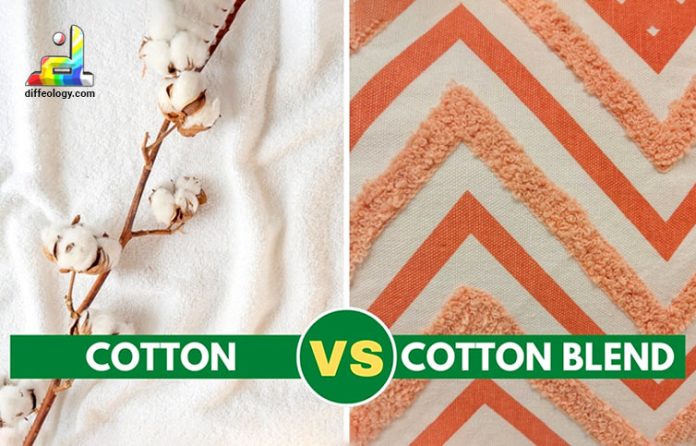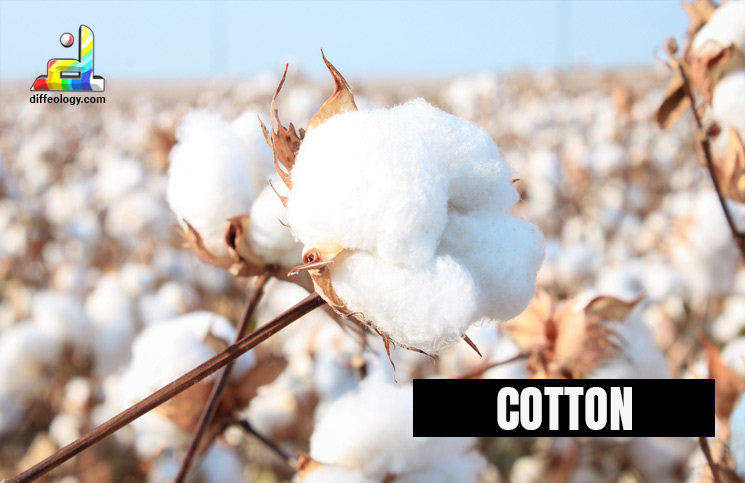Two separate kinds of fabrics that have a significant role to play in the textile industry include cotton and cotton blends, which offer different attributes. Cotton, made from fibers in the cotton plant, is known for its natural softness and comfort to one’s skin. Yet, cotton blends are produced through the merging of different fibers like polyester and spandex to gain certain characteristics such as strength, stretch, or crease resistance. Recognition of the Difference Between Cotton and Cotton Blend is fundamental for consumers as they make decisions based on preferences, functionality, and what a particular clothing piece or textile item will be used for.
The Main Difference Between Cotton and Cotton Blend
Cotton is an entirely natural product that originates from the cotton plant. Yet, cotton Blend is a blend of cotton and other fibers, such as polyester or spandex. Cotton is soft and gentle on the skin. The texture and feel of the cotton blend may differ in accordance with the composition. Cotton is Ideal for various clothing items, including casual and formal wear. Cotton Blend is Ideal for items that require added durability, like workwear.
Cotton Vs. Cotton Blend
What is Cotton?
Cotton refers to a natural fiber that is derived from the fluffy seed fibers of the cotton plant (Gossypium). This plant bears bolls, which are pod-like capsules with seeds enclosed in soft fibers. These fibers, when matured, are carefully collected and processed into cotton fabric. Cotton, with its famed multipurpose character, is quite popular in terms of the textile industry because it keeps things soft and comfortable and, moreover, breathable. It has been an important part of the textile industry for centuries, most importantly in clothes such as t-shirts, jeans, and dresses, but also in domestically used items like bed sheets and towels.
Read Also: Difference Between Jumpers and Cardigans
Cotton grows well in hot regions and is grown throughout the world. Cotton production consists of germination, development, and reaping the lint. Fibers are consequently separated from the seeds and go through additional manufacturing to make the cotton fabric that we typically use. Indeed, due to its inherent qualities and flexibility, cotton remains a beloved material appreciated for comfortability while supporting people in making an assortment of everyday products.
What is Cotton Blend?
A cotton blend is a fabric produced by blending the base fibers, such as polyester spandex or rayon, with an original one; namely, in this case, it refers to cotton. The objective of blending is to leverage the distinct properties of cotton and other fibers, thereby creating a product with improved performance. Cotton blends provide a flexible option, as the nature of fabrics can be modified in order to suit different needs, including higher strength, elasticity, or wrinkle resistance.
Read Also: Difference Between Tuxedo and Suit
Cotton blended with synthetic fibers presents a fabric that possesses certain desirable features of pure cotton while taking advantage of the additional materials. Along with everyday items such as shirts and pants, these blends can also be found in specialized cases of activewear or workwear. Cotton blends have most likely become mainstream in the textile sector as consumers enjoy a wonderful compromise between the natural comfort offered by pure cotton and technical enhancements introduced with fiber mixes.
Comparison Table “Cotton Vs. Cotton Blend”
| Composition | Pure natural fiber from cotton plant. | Combination of cotton with other fibers. |
| Softness | Naturally soft and gentle against the skin. | Texture can vary depending on the blend. |
| Breathability | Highly breathable, allowing good airflow. | It can have a lower level of breathability. |
| Durability | Durable but may be prone to wrinkles. | Enhanced durability, especially against wear. |
| Shrinkage | Susceptible to shrinkage, especially in heat. | Less prone to shrinkage compared to pure cotton. |
| Wrinkle Resistance | Prone to wrinkling, especially without ironing. | It may have improved resistance to wrinkles. |
| Cost | Generally more expensive due to cultivation. | Often more cost-effective than pure cotton. |
| Color Retention | Retains color well but may fade over time. | It may have reduced sensitivity to dyes, leading to better color retention. |
| Versatility | Versatile, suitable for various clothing items. | Diverse in terms of available blends and applications. |
| Ironing Requirements | It may require more ironing to maintain appearance. | It may require less ironing compared to pure cotton. |
| Drying Time | Longer drying time compared to some blends. | It may have a faster drying time. |
| Environmental Impact | More environmentally friendly. | Less environmentally friendly due to synthetic fiber content. |
| Resistance to Pests and Mold | Susceptible to pests and mold. | Resistant to pests and mold due to synthetic fibers. |
| Specific Applications | Ideal for various clothing items. | Ideal for items that require added durability, like workwear. |
| Affordability and Quality | Generally more expensive but reflects quality. | Offers a balance between affordability and quality. |
Difference Between Cotton and Cotton Blend in Detail
1. Composition:
The fibers of the cotton plant are used to make Cotton fabric, which is predominantly cellulose. The fibers are extracted from the cotton bolls and twisted into yarn, which is either stitched or knitted together to form different textile items. Because of its purity, cotton is breathable, soft, and comfortable to wear on different kinds of clothing.
Yet, a cotton blend is composed of blending the cotton with other fibers such as polyester spandex or rayon. The purpose of the blend is to improve certain cotton properties such as toughness, stretchiness, or crease resilience. This blend is usually characterized by a hybrid fabric, which still retains some of the benefits that are associated with pure cotton but also includes others for natural fibers.
2. Durability:
Cotton fabrics are famous for being very durable, especially if well taken care of. Given proper maintenance, cotton retains its structural integrity with regular washing and use. Yet overwashing or exposure to rough conditions can cause some extent of shrinkage.
Cotton blends are, in general, stronger than pure cotton fabrics. The inclusion of artificial fibers such as polyester strengthens the fabric by increasing its wrinkle resistance, fading, and wear. This gives cotton blends an advantageous place in garments that ought to withstand everyday use and regular cleaning while retaining their shape as well as color.
3. Breathability:
Cotton is highly permeable and allows air to pass freely through the fibers. This inherent feature allows cotton clothes to be worn in hot weather since it helps maintain the balance of body temperature and prevents excessive perspiration.
Cotton blends vary in the degree of breathability that is retained, depending on what additional fibers have been introduced. Nevertheless, the introduction of synthetic materials slightly lowers the total breathability compared to pure cotton. It is imperative that the specific combination be taken into account, considering the desired comfort level for different weather conditions.
4. Softness:
Cotton is famous for its smooth texture. The lightness offered by the natural fibers also ensures a smooth touch on one’s skin, making cotton clothes an ideal option for people with fragile or sensitive skin individuals who prefer wearing garments that feel soft.
The softness level of cotton blends also may differ based on the types and ratios of added fibers. Some blends can retain cotton’s softness while others may feel differently, providing a compromise between softness and the features of combined materials.
5. Cost:
Cotton products are also often pricey, but this is because of the intensive cultivation and processing needed for them to be pure. The price is a reflection of the quality and nature that characterize this material.
Cotton blends tend to be more economical than pure cotton. Thus, the incorporation of synthetic fibers results in a fabric that is more affordable without retaining essential beneficial qualities and hence presents an economical choice for customers.
6. Shrinkage:
Yet, one possible problem of pure cotton is its shrinking tendency when the clothes are exposed to high temperatures, such as during washing and drying. This problem is often rectified by pre-shrinking processes.
Cotton blends, especially those containing synthetic fibers, are less likely to shrink in comparison with pure cotton. The extra fibers increase the stability of the fabric and prevent large size changes after washing.
7. Versatility:
Cotton is a versatile fabric that works for everything from t-shirts and jeans to dresses or bedding. It is also easy to work with the piece as it can be used for both casual and formal wear.
Cotton blends provide flexibility by mixing the characteristics of cotton with those of additional fibers. This adaptability makes it possible to manufacture fabrics that are customized for different users, including more stretch in activewear and greater strength of work wear.
Key Points Difference Between Cotton and Cotton Blend
- Breathability: Cotton is Highly breathable, allowing good air circulation. Cotton Blend can have a lower level of breathability than pure cotton.
- Durability: Cotton is Durable but may be prone to wrinkles. Cotton Blend Enhanced durability, especially against wrinkles and wear.
- Shrinkage: Cotton is Susceptible to shrinkage, especially in hot water or high-heat drying. Cotton Blend is less prone to shrinkage than pure cotton.
- Wrinkle Resistance: Cotton Prone to wrinkling, especially without prompt ironing. Cotton Blend may improve resistance to wrinkles.
- Cost: Cotton is generally more expensive due to cultivation and processing. Cotton Blend is Often more cost-effective than pure cotton.
- Color Retention: Cotton Retains color well but may fade over time. Cotton Blend May have reduced sensitivity to dyes, leading to better color retention.
- Versatility: Cotton is versatile and suitable for various clothing items. Cotton Blend Diverse in terms of available blends and applications.
- Texture Variation: Cotton Consistent soft texture. Cotton Blend Texture can vary depending on the blend.
- Ironing Requirements: Cotton May require more ironing to maintain its appearance. Cotton Blend May require less ironing compared to pure cotton.
- Drying Time: Cotton has a longer drying time compared to some blends. Cotton Blend May have a faster drying time.
- Resistance to Pests and Mold: Cotton is susceptible to pests and mold. Cotton Blend Resistant to pests and mold due to synthetic fibers.
- Environmental Impact: Cotton is more environmentally friendly. Cotton Blend is less environmentally friendly due to its synthetic fiber content.
- Diversity in Styles: Cotton is Available in a variety of styles. Cotton Blend is available in diverse blends catering to different preferences.
- Affordability and Quality: Cotton is generally more expensive but reflects the quality. Cotton Blend offers a balance between affordability and quality.
FAQs: Cotton Vs. Cotton Blend
Conclusion:
Finally, the decision between cotton and mixed fabrics depends on each person’s preference as well as what they need in terms of clothing materials or textiles. Pure cotton continues to be an eternal classic for those who seek natural comfort and breathability. Its texture on the skin and adaptability make it suitable for many kinds of clothes and household items.
The Difference Between Cotton and Cotton Blend is simple. Cotton combinations present a range of options that marry the best from either camp by employing the advantages of other fibers. Whether it is the increased strength for workwear active wear’s flexibility or wrinkle resistance in everyday clothing, cotton blends have defined a new niche within textiles. Finally, it depends on understanding the specific characteristics of different fabric types and that your choice is appropriate to a particular wearer’s needs.
References & External Links
- A Complete Guide to the Cotton History, Characteristics, and Uses of Cotton.



